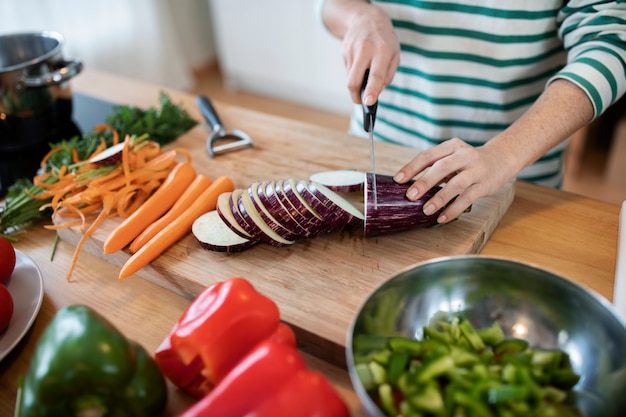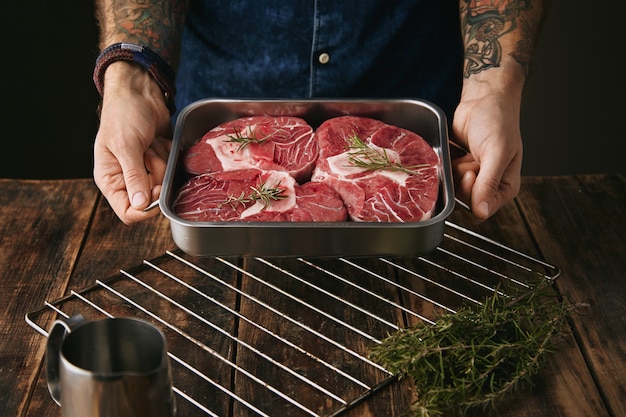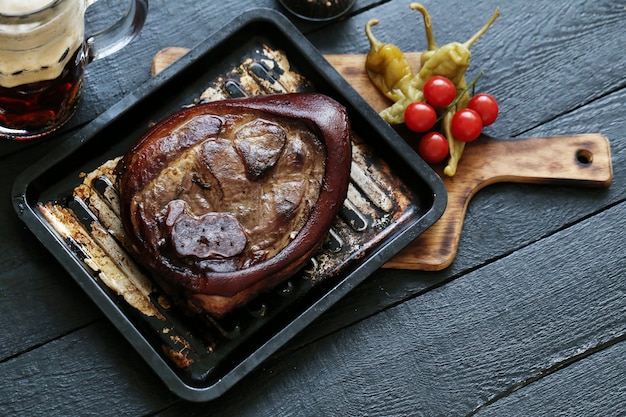Ah, the glorious medium steak! That irresistible pink center, the satisfying char on the outside, the symphony of flavors dancing on your tongue - it's a culinary masterpiece. But achieving that perfect medium can be tricky, especially for those of us who aren't grill masters. I've been there, staring at a hunk of beef with a mix of excitement and trepidation. Will it be tender and juicy, or dry and tough? Will it be cooked to my liking, or end up resembling a charcoal briquette?
Through countless trials and errors, I've learned a thing or two about perfecting the medium steak. It's not just about tossing it on the grill and hoping for the best. There are some key factors to consider, and I'm here to share my wisdom, gleaned from countless kitchen experiments. Grab a notepad, a chilled beverage, and let's dive into this culinary adventure together.
(Part 1) The Quest for the Perfect Medium

The Art of Doneness
First things first, let's clear up the concept of "medium." It's not a one-size-fits-all term. It's subjective, influenced by personal preference and the cut of meat. Some prefer a bit more pink, others like a hint of brown. For me, "medium" is a tender, juicy center with a slightly browned exterior. It's the happy medium between rare and well-done, a point where the flavors are perfectly balanced and the texture is divine.
The Importance of internal temperature
The most reliable way to ensure your steak is cooked to your liking is by using a meat thermometer. It's the golden standard, eliminating guesswork and providing precise readings. The ideal internal temperature for a medium steak is 145°F (63°C). Forget about the old "thumb test" or relying solely on visual cues - they can be deceiving. Invest in a good thermometer and use it!
Factors Influencing Cook Time
Now, the time it takes to achieve that perfect medium depends on several factors:
- Thickness: A thicker steak will naturally require a longer cooking time to reach the desired internal temperature.
- Cut: Different cuts of beef have varying densities, affecting how quickly they cook. For instance, a tender filet mignon will cook faster than a thicker ribeye.
- Cooking Method: Grilling, pan-frying, and oven-roasting all have different heat levels and cooking times. Grilling typically offers a more intense heat and faster cooking time compared to oven roasting.
- Desired Doneness: A medium-rare steak will require less time than a medium-well steak. The higher the desired doneness, the longer the cooking time.
(Part 2) Mastering the Grill

Choosing the Right Grill
For the quintessential steak experience, there's nothing quite like the smoky aroma and crisp char that only a good grill can deliver. But not all grills are created equal. Gas grills offer convenience and speed, while charcoal grills impart a more intense smoky flavor. If you're aiming for that traditional, smoky taste, charcoal is the way to go. But if time is a constraint, a gas grill will suffice.
Preparing the Grill
Before you even think about placing your steak on the grill, make sure it's preheated to high heat. This is crucial for achieving that beautiful sear and locking in the juices. A good rule of thumb is to preheat your grill for about 15 minutes before grilling. A hot grill ensures that the steak develops a nice crust and prevents it from sticking.
Seasoning Your Steak
There's no need for elaborate seasoning. Keep it simple with your best friends: salt and pepper. Season your steak generously on both sides, right before you put it on the grill. Salt draws out moisture, so don't season too early, or your steak might become dry. Always opt for fresh, cracked peppercorns over pre-ground for a more robust flavor.
Grilling Technique
This is where the real magic happens. For a perfect medium steak, you'll need to create a beautiful sear on both sides and then lower the heat to finish cooking to the desired internal temperature. Here's my preferred method:
- High Heat Sear: Place the steak on the hottest part of the grill and cook for 2-3 minutes per side. The goal is to achieve a nice crust and seal in the juices. Don't move it around too much - let it cook undisturbed for that perfect char.
- Lower Heat Finish: Move the steak to a cooler part of the grill or reduce the heat to medium. Continue cooking for another 4-6 minutes per side, depending on the thickness of the steak and your desired doneness. Remember, it's always better to slightly undercook than overcook. You can always cook it a bit longer if needed, but you can't undo overcooking.
- Resting Time: Once the steak reaches the desired internal temperature, remove it from the grill and let it rest for 5-10 minutes before slicing. This allows the juices to redistribute, resulting in a more tender and flavorful steak.
(Part 3) The Pan-Frying Method

Choosing the Right Pan
For pan-frying, you need a heavy-bottomed pan that can distribute heat evenly. Cast iron is a classic choice, but a good quality stainless steel pan will do the job. Make sure your pan is nice and hot before adding the steak. A hot pan ensures a crisp sear and prevents the steak from sticking.
Seasoning and Technique
Follow the same seasoning guidelines as for grilling. Season your steak liberally with salt and pepper just before cooking. Heat your pan over high heat and add a small amount of oil, just enough to coat the bottom of the pan. Place the steak in the pan and let it cook undisturbed for 2-3 minutes per side to achieve a beautiful sear. Then, reduce the heat to medium and continue cooking for another 4-6 minutes per side, depending on thickness and doneness.
The Importance of Temperature Control
The key to pan-frying a perfect medium steak is maintaining the right temperature. If the pan gets too hot, the steak will burn on the outside and be raw on the inside. If the pan is too cold, the steak won't sear properly and will be tough. Use a meat thermometer to monitor the internal temperature and adjust the heat accordingly.
(Part 4) Oven-Roasted Steak
Prepping and Roasting
For a more hands-off approach, you can roast your steak in the oven. Preheat your oven to 400°F (200°C). Season your steak liberally with salt and pepper and place it on a baking sheet. For an extra layer of flavor, consider searing the steak in a pan before roasting, just like you would for pan-frying.
roasting time
The roasting time will vary depending on the thickness of your steak. As a general guideline, roast for 10-15 minutes per side for a medium steak. Use a meat thermometer to check the internal temperature. Once the steak reaches 145°F (63°C), remove it from the oven and let it rest for 10 minutes before slicing. This allows the juices to redistribute for a more tender steak.
Adding Flavor
To elevate your oven-roasted steak, try adding some herbs and spices to the baking sheet. Rosemary, thyme, and garlic are all great options. You can also add a splash of wine or broth to the baking sheet for added moisture and flavor.
(Part 5) steak cuts and Their Cook Times
Popular steak cuts
Not all cuts of beef are created equal when it comes to tenderness and flavor. Here are some of the most popular steak cuts and their estimated cooking times for a medium steak:
| Steak Cut | Thickness (inches) | Approximate Cook Time (minutes) |
|---|---|---|
| Ribeye | 1 | 10-12 |
| new york strip | 1.5 | 15-18 |
| Filet Mignon | 1 | 8-10 |
| Sirloin | 1 | 10-12 |
| T-bone | 1.5 | 15-18 |
Remember, these are just estimates. Always use a meat thermometer to ensure your steak is cooked to your liking.
(Part 6) Beyond the Basics: Techniques and Tips
reverse searing
For a more evenly cooked steak, try reverse searing. This technique involves cooking the steak slowly over low heat until it's almost fully cooked, then searing it over high heat to create a beautiful crust. This method results in a steak that is tender and juicy throughout, as the slow cooking prevents overcooking while the searing adds that delicious char.
Sous Vide
If you're seeking a truly foolproof method for achieving perfectly cooked steak, try sous vide cooking. This technique involves sealing the steak in a vacuum bag and immersing it in a water bath at a precise temperature. Sous vide ensures that the steak cooks evenly and reaches the desired internal temperature without overcooking. After sous vide, you can sear the steak for a crispy exterior. This method is especially beneficial for thick cuts of meat, as it helps to create a consistent doneness throughout.
Don't Overcook!
It's tempting to overcook a steak, but resist the urge! Overcooked steak is dry and tough, and the flavor is compromised. It's always better to err on the side of undercooked. You can always cook it a bit longer if needed, but you can't undo overcooking. Remember, a little pink is a good thing!
(Part 7) Steak Accessories: A Culinary Symphony
The Right side dishes
A perfect steak deserves a symphony of flavors on the side. Here are a few of my favorites that complement the richness of a perfectly cooked steak:
- grilled vegetables: Asparagus, bell peppers, zucchini, and onions grilled to perfection, adding a burst of fresh flavor and color to your plate.
- Creamy mashed potatoes: Creamy, buttery mashed potatoes are the ultimate comfort food and provide a lovely contrast in texture to the steak.
- Roasted Root Vegetables: Carrots, parsnips, and potatoes roasted in the oven with herbs and spices offer a satisfying earthy sweetness.
- Green Salad: A simple green salad with a light vinaigrette adds freshness and balance to the meal, cutting through the richness of the steak.
The Perfect Wine Pairing
A good wine pairing elevates the steak experience to new heights. Here are a few classic pairings that enhance the flavors of your steak:
- Cabernet Sauvignon: This full-bodied red wine complements the richness of a ribeye or New York strip, offering bold tannins that stand up to the steak's flavor.
- Merlot: A smoother, more approachable red wine that pairs well with a sirloin or T-bone, offering a balanced fruity flavor profile.
- Zinfandel: A fruit-forward red wine that complements the bold flavors of a filet mignon, offering a touch of spice and acidity to cut through the richness.
(Part 8) FAQs: Your Steak Questions Answered
1. What if my steak is overcooked?
If you've overcooked your steak, don't fret! While you can't undo the damage completely, you can still salvage it. Slicing the steak thinly can help to make it more tender. You can also try adding a rich sauce to mask the dryness. And remember, next time, be extra careful to avoid overcooking!
2. Can I use a meat thermometer on a thick steak?
Absolutely! A meat thermometer is essential for ensuring a perfectly cooked steak, regardless of its thickness. It provides precise readings and eliminates guesswork. If your steak is thick, insert the thermometer into the thickest part to get the most accurate reading.
3. How do I know if my steak is cooked to medium?
The most reliable way is to use a meat thermometer and check for an internal temperature of 145°F (63°C). However, if you're not using a thermometer, you can use the "thumb test." Press on the center of the steak; it should feel firm but still springy, like the tip of your nose.
4. What's the best way to clean my grill after cooking a steak?
After grilling, let the grill cool down slightly, then use a grill brush to remove any food debris. If there are any stubborn bits, soak a paper towel in water and place it on the grill for a few minutes, then scrape with a grill brush. For a deeper clean, you can use a grill cleaner and follow the manufacturer's instructions.
5. Can I freeze steak before cooking it?
While freezing steak is fine, it can affect the texture and tenderness. It's best to defrost the steak in the refrigerator overnight before cooking. This will help ensure that the steak cooks evenly and retains its tenderness. If you must freeze, wrap the steak tightly in plastic wrap or freezer paper to prevent freezer burn.
Remember, cooking a perfect medium steak is a journey, not a destination. Don't be afraid to experiment, learn from your mistakes, and enjoy the process. And above all, have fun! There's nothing quite like the satisfaction of a beautifully cooked steak that melts in your mouth.
Everyone is watching

Corn on the Cob: The Ultimate Guide to Perfectly Cooked Ears
Healthy MealsAh, corn on the cob. Just the name evokes images of sunny days, barbecues, and that sweet, juicy flavour that ...

Scallops: The Ultimate Guide to Perfect Cooking
Healthy MealsAh, scallops. Those delicate, sweet, and utterly delicious morsels of the sea. They hold a special place in my...

Spaghetti Squash: The Ultimate Guide to Cooking and Serving
Healthy MealsRemember that time you saw spaghetti squash at the supermarket, looking all bumpy and strange, and thought, "W...

Salmon Cooking Times: Perfect Guide for Every Recipe
Healthy MealsLet me tell you, cooking salmon is an art form. It's all about getting that perfect balance: juicy and tender,...

Ham Cooking Time: How Long to Bake, Smoke, or Boil a Delicious Ham
Healthy MealsAh, ham. It's a classic, isn't it? A real crowd-pleaser, especially around holidays. And when done right, it'...
